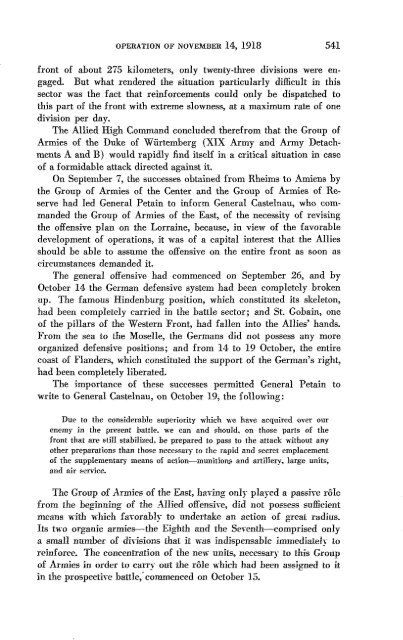COAST ARTILLERY, JOURNAL - Air Defense Artillery
COAST ARTILLERY, JOURNAL - Air Defense Artillery
COAST ARTILLERY, JOURNAL - Air Defense Artillery
You also want an ePaper? Increase the reach of your titles
YUMPU automatically turns print PDFs into web optimized ePapers that Google loves.
OPERATION OF NOVEMBER 14, 1918 541<br />
front of about 275 kilometers, only twenty-three divisions were engaged.<br />
But what rendered the situation particularly difficult in this<br />
sector was the fact that reinforcements could only be dispatched to<br />
this part of the front with extreme slowness, at a maximum rate of one<br />
division per day.<br />
The Allied High Command concluded therefrom that the Group of<br />
Armies of the Duke of Wiirtemberg (XIX Army and Army Detach.<br />
ments A and B) would rapidly find itself in a critical situation in case<br />
of a formidable attack directed against it.<br />
On September 7, the successes obtained from Rheims to Amiens by<br />
the Group of Armies of the Center and the Group of Armies of Reserve<br />
had led General Petain to inform General Castelnau, who commanded<br />
the Group of Armies of the East, of the necessity of revising<br />
the offensive plan on the Lorraine, because, in view of the favorable<br />
development of operations, it was of a capital interest that the Allies<br />
should be able to assume the offensive on the entire front as soon as<br />
circumstances demanded it.<br />
The general offensive had commenced on September 26, and by<br />
October 14 the German defensive system had been completely broken<br />
up. The famous Hindenburg position, which constituted its skeleton,<br />
had been completely carried in the battle sector; and St. Gobain, one<br />
of the pillars of the Western Front, had fallen into the Allies' hands.<br />
From the sea to the Moselle, the Germans did not possess any more<br />
organized defensive positions; and from 14 to 19 October, the entire<br />
coast of Flanders, which constituted the support of the German's right,<br />
had been completely liberated.<br />
The importance of these successes permitted General Petain to<br />
write to General Castelnau, on October 19, the following:<br />
Due to the considerable superiority which we have acquired over our<br />
enemy in the present battle. we can and should. on those parts of the<br />
front that are stilI stabilized, be prepared to pass to the attack without any<br />
other preparations than those necessary to the rapid and secret emplacement<br />
of the supplementary means of action-munition;; and artillery, large units,<br />
and air sen"ice.<br />
The Group of Armies of the East, having only played a passive role<br />
from the beginning of the Allied offensive, did not possess sufficient<br />
means with which favorably to undertake an action of great radius.<br />
Its two organic armies--the Eighth and the Seventh-comprised only<br />
a small number of divisions that it was indispensable immediately to<br />
reinforce. The concentration of the new units, necessary to this Group<br />
of Armies in order to carry out the rOle which had been assigned to it<br />
in the prospective battle,. commenced on October 15.
















